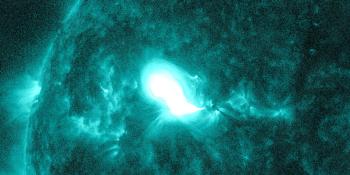Visualizzazione archivio di mercoledì, 20 marzo AM
Rapporto attività solare
Ogni brillamento solare menzionato nel rapporto ha un fattore di scala, applicato dal Centro di Predizione Meteorologica Spaziale (SWPC). A causa del fattore di scala del SWPC, i brillamenti solari sono segnalati come ridotti del 42%, rispetto ai dati di qualità scientifica. Il fattore di scala è stato rimosso dai nostri dati archiviati sui brillamenti solari, per riflettere le unità fisiche reali.
Rapporto dell'Attività Geofisica Solare 2002 Mar 20 2200 UTCPreparati dal SWPC della NOAA© ed elaborati da SpaceWeatherLive.com
Rapporto Congiunto USAF/NOAA dell'Attività Solare e Geofisica
SDF Numero 079 Emesso alle 2200Z il Mar 20 2002IA. Analisi delle Regioni Solari Attive e Attività dalle 2100Z-19 alle 2100Z-20 Solar activity was low. A long-duration C4 flare began
at 1544 UTC and lasted until 1919 UTC. The corresponding source on
the disk was not entirely certain but it seemed most likely to be
correlated to activity observed in Region 9866 (S08W73). Additional
C-class subflares occurred during the day, with many of these coming
from Region 9875. Region 9875 showed steady growth during the past
24 hours. Three new region were assigned today: 9876 (S16E65), 9877
(N18W29), and 9878 (N08E75).
IB. Previsione dell'Attività Solare
Solar activity is expected to be low
to moderate during the next three days.
IIA. Sommario dell'Attività Geofisica dalle 2100Z-19 alle 2100Z-20
The geomagnetic field was quiet until 1329 UTC when a sudden impulse
(SI) occurred. Since then the geomagnetic field has ranged from
quiet to active levels. The SI was caused by an interplanetary shock
which was seen at the ACE spacecraft at 1307 UTC. The disturbance is
most likely the result of the halo CME was observed in LASCO C2 at
18/0254 UTC. The shock also pushed the greater than 10 MeV proton
fluxes up to about 19 PFU at 1525 UTC. The proton event fluxes
dropped below event level at 1820 UTC.
IIB. Previsione dell'Attività Geofisica
The geomagnetic field is
expected to be mostly unsettled for the next three days. There is a
chance for some isolated active levels on the second day as a
possible response to yesterday's partial halo CME.
III. Probabilità dell'Evento dalle Mar del 21 alle Mar del 23
| Classe M | 50% | 50% | 50% |
| Classe X | 05% | 05% | 05% |
| Protone | 10% | 10% | 05% |
| PCAF | yellow | ||
IV. Flusso di 10.7 cm di Penticton
Osservato 20 Mar 188 Previsto 21 Mar-23 Mar 175/170/165 Media di 90 Giorni 20 Mar 213
V. Indici Geomagnetici A
Osservato Afr/Ap 19 Mar 015/017 Stimato Afr/Ap 20 Mar 010/010 Previsto Afr/Ap 21 Mar-23 Mar 010/010-015/015-010/008
VI. Probabilità dell'Attività Geomagnetica dal 21 Mar al 23 Mar
| A. Latitudini Medie | |||
|---|---|---|---|
| Attivo | 25% | 35% | 25% |
| Tempesta minore | 20% | 25% | 20% |
| Tempesta maggiore-grave | 10% | 15% | 10% |
| B. Latitudini Alte | |||
|---|---|---|---|
| Attivo | 25% | 35% | 25% |
| Tempesta minore | 20% | 25% | 20% |
| Tempesta maggiore-grave | 10% | 15% | 10% |
Tutti gli orari in UTC
<< Vai alla pagina della panoramica giornaliera
Ultime notizie
Ultimi messaggi dal forum
AR13901 11/25/2024 possible CME 22jsoc 15Nasa engineers meet “ smarter every day” 5Coronal mass ejection impact and G4 geomagnetic storm 10 & 11 October 2024 933>500 meV 24
Altri argomentiSupporta SpaceWeatherLive.com!
Molte persone vengono su SpaceWeatherLive per seguire l'attività del Sole o sapere se ci sia la possibilità di vedere l'aurora, ma a maggior traffico corrispondono costi maggiori. Considerate una donazione se vi piace SpaceWeatherLive così che possiamo mantenere online il sito web!

Notizie sul meteo spaziale
| Ultimo brillamento X | 2024/11/06 | X2.39 |
| Ultimo brillamento M | 2024/11/27 | M1.0 |
| Ultima tempesta geomagnetica | 2024/11/10 | Kp5+ (G1) |
| Giorni senza macchie | |
|---|---|
| Ultimo giorno senza macchie | 2022/06/08 |
| Media mensile Numero di Macchie Solari | |
|---|---|
| ottobre 2024 | 166.4 +25 |
| novembre 2024 | 145.7 -20.7 |
| Last 30 days | 151.4 -3.3 |


